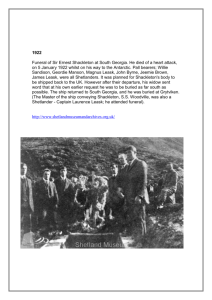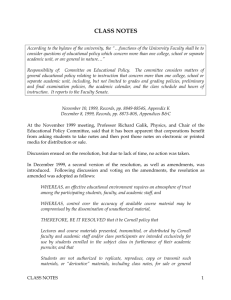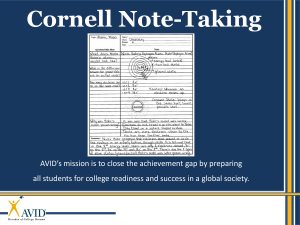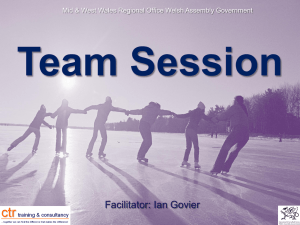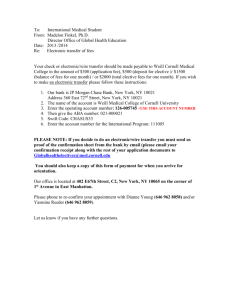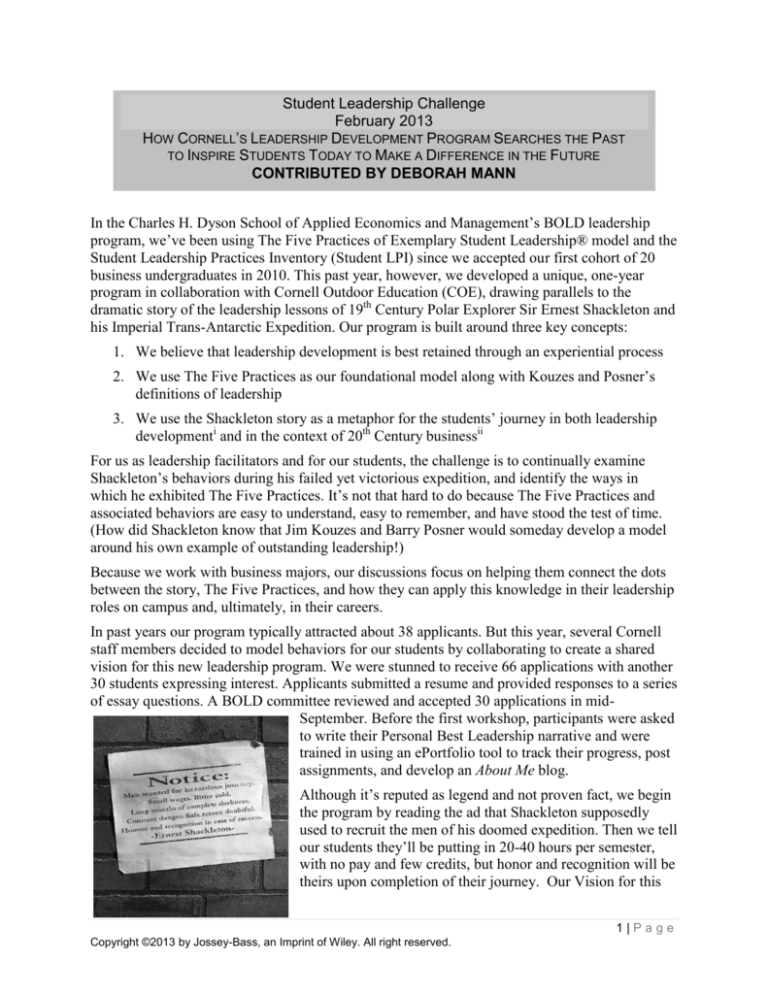
Student Leadership Challenge
February 2013
HOW CORNELL’S LEADERSHIP DEVELOPMENT PROGRAM SEARCHES THE PAST
TO INSPIRE STUDENTS TODAY TO MAKE A DIFFERENCE IN THE FUTURE
CONTRIBUTED BY DEBORAH MANN
In the Charles H. Dyson School of Applied Economics and Management’s BOLD leadership
program, we’ve been using The Five Practices of Exemplary Student Leadership® model and the
Student Leadership Practices Inventory (Student LPI) since we accepted our first cohort of 20
business undergraduates in 2010. This past year, however, we developed a unique, one-year
program in collaboration with Cornell Outdoor Education (COE), drawing parallels to the
dramatic story of the leadership lessons of 19th Century Polar Explorer Sir Ernest Shackleton and
his Imperial Trans-Antarctic Expedition. Our program is built around three key concepts:
1. We believe that leadership development is best retained through an experiential process
2. We use The Five Practices as our foundational model along with Kouzes and Posner’s
definitions of leadership
3. We use the Shackleton story as a metaphor for the students’ journey in both leadership
developmenti and in the context of 20th Century businessii
For us as leadership facilitators and for our students, the challenge is to continually examine
Shackleton’s behaviors during his failed yet victorious expedition, and identify the ways in
which he exhibited The Five Practices. It’s not that hard to do because The Five Practices and
associated behaviors are easy to understand, easy to remember, and have stood the test of time.
(How did Shackleton know that Jim Kouzes and Barry Posner would someday develop a model
around his own example of outstanding leadership!)
Because we work with business majors, our discussions focus on helping them connect the dots
between the story, The Five Practices, and how they can apply this knowledge in their leadership
roles on campus and, ultimately, in their careers.
In past years our program typically attracted about 38 applicants. But this year, several Cornell
staff members decided to model behaviors for our students by collaborating to create a shared
vision for this new leadership program. We were stunned to receive 66 applications with another
30 students expressing interest. Applicants submitted a resume and provided responses to a series
of essay questions. A BOLD committee reviewed and accepted 30 applications in midSeptember. Before the first workshop, participants were asked
to write their Personal Best Leadership narrative and were
trained in using an ePortfolio tool to track their progress, post
assignments, and develop an About Me blog.
Although it’s reputed as legend and not proven fact, we begin
the program by reading the ad that Shackleton supposedly
used to recruit the men of his doomed expedition. Then we tell
our students they’ll be putting in 20-40 hours per semester,
with no pay and few credits, but honor and recognition will be
theirs upon completion of their journey. Our Vision for this
1|Page
Copyright ©2013 by Jossey-Bass, an Imprint of Wiley. All right reserved.
expedition to build their leadership capacity through self-development and mastery of selfawareness, building relationships based on trust and appreciation of differences, team bonding,
practice, and making a difference toward their future success.
We use a variety of workshops and tools, as well as a unique approach to conflict resolution.
Students uncover their potential and that of their team members through Gallup’s
StrengthsQuest™, Myers Briggs Type Indicator®, The Medicine (or Leadership) Wheeliii, Student
Leadership Practices Inventory, Finding Your Flow, and Sustainable Leadership. One of the
most effective tools that deliver hands-on learning of the Practices is our intensive wilderness
trip. Each group of 10 students is assigned a Practice and asked to take note when they
themselves display that Practice or when they see others doing so. On a recent trip, students
immediately were overheard talking about the Practices (without any facilitation). At one point,
they were heard arguing about where to sleep for the night, and someone suggested that perhaps
they were having problems because they didn’t first Inspire a Shared Vision to set a plan in
place. Our Teaching Assistant continued to hear them congratulate each other on Challenging the
Process or Encouraging The Heart!
So, here is how we navigate:
Fall Semester
Writing Personal Best narrative and reading the Shackleton story excerpt from Leading
at the Edge.
The Journey Begins: Building the Team & Finding Your True North: Define
leadership, introduce The Five Practices and the Student LPI, share Personal Best stories
and identify Practices within each student’s story; Value Sort, teambuilding on low ropes
course elements; and The Endurance movie. Students engage in a series of experiential
indoor and outdoor ropes course activities focused on each of The Five Practices.
Enduring Leadership and The Pursuit of Virtue: Lecture by Dan Torpey, Ernst &
Young Executive CPA, who has used the Shackleton story with his own executive
leadership team. Our subsequent discussions examine ways that Mr. Torpey Challenged
the Process or Encouraged the Heart in leading this teams.
Finding Your Flow Workshop: Developing the Mindset and Skills of a Champion
Leader with Dr. Bruce H. Jackson of The Institute of Applied Human Excellence
(http://www.theiahe.com). The workshop help students identify and repeat the behaviors
they want to spend more time on to achieve their personal best performance.
Navigating Through Treacherous Seas: Plotting Your Passage: Intensive Wilderness
Backpacking Challenge in a Train-the-Trainer program (open to 10 students from the
cohort).
StrengthsQuest™ Workshop: Students examine their own Signature Themes and that of
their team members, discuss what they think Shackleton’s top Strengths would be, and
have to “sell” themselves to their team members based on their Top 5 Themes.
Leadership Wheel Workshop: Cornell Outdoor Education delivers experiential
exercises to help students understand their position on the Wheel, what gets them into
trouble, and how to work more effectively with people who are different from them. The
2|Page
Copyright ©2013 by Jossey-Bass, an Imprint of Wiley. All right reserved.
students identify ways that Shackleton moved in every direction on the wheel as he
moved from one Practice to another.
Developing a Sustainable Crew (Part I): This workshop is conducted by the GIVE
LEADERSHIP Institute and utilizes StrengthsQuest™ and Leadership Wheel assessments
to help students begin to understand how to resolve conflict in the workplace.
Student Leadership Practices Inventory (1st Assessment): Students complete the
Student LPI: Self and also serve as Observers for three team members. Teaching
Assistants and facilitators assess each student as Observers, too.
Students turn in a StrengthsQuest™ Orienteering narrative assignment: They are
asked to form a fictional company and assign team members to lead various departments
based on their identified strengths (e.g., Developing the Vision, Strategic Plan, Crisis
Management, Customer Service). They are also asked to explain ways they will Model
the Way, Challenge the Process at Cornell, Encourage the Heart of their team members,
what it takes to create and Inspire a Shared Vision, and what it means to Enable Others to
Act to build a culture of trust and cooperative relationships.
Spring Semester
Coaching Session and Review of the student’s Student LPI results with program
administrator.
Setting the Sights: Review, regroup, and chart the course for Spring Semester through
an interactive World Café format.
Dealing with Mutiny: Case study prep to learn how to resolve conflict with a heart of
peace.
Developing a Sustainable Crew (Part II): More work on resolving conflict through role
playing.
MBTI Workshop: Cornell Outdoor Education delivers this via an experiential method.
Green Business Lab: This is a capstone, 14-hour business simulation lab delivered by
Realia Group, Inc. that focuses on business success with a triple bottom line of economic,
social, and environmental responsibility. Pre-assignments require about 2 hours of
student prep.
Student LPI Assessment and Coaching: Program administrators use these one-on-one
meetings to deliver the Student LPI Report, evaluate the student’s understanding of the
results, discuss their engagement and performance, review their online ePortfolio and,
most importantly, listen to their evaluations and suggestions for improvement on our
programming.
Navigating Treacherous Seas: Plotting Your Passage (Part II): Train-the-Trainer
Level Two Extreme Challenge Wilderness Backpacking Trip.
Celebrating the Triumph: High Ropes Course activities to point out and cement the
learning of The Five Practices, Award Ceremony, Campfire Dinner. Certificates are
granted and a BOLD LinkedIn lineage is created to network all of our Leadership
Certificate Teams since 2010.
3|Page
Copyright ©2013 by Jossey-Bass, an Imprint of Wiley. All right reserved.
We were fortunate to have Dr. Posner speak at Cornell last April when we announced this
program for the first time. Students engaged in a dramatic introduction that evening just prior to
his presentation. We hope he enjoyed learning about a unique way that The Five Practices of
Exemplary Student Leadership® were going to be used to develop Cornell’s business leaders!
Because of our success and funding from the C. Charles Jackson Foundation, next year Cornell
Outdoor Education will be rolling this same model out to all Cornell University students from
every discipline.
Deborah Mann, Cornell University Leadership Program Administrator, has administered the
Dyson School’s leadership program since 2007 (130 students), and is a Certified Facilitator of
The Student Leadership Challenge. Deb also has been an admirer of Shackleton’s leadership for
years and was fortunate to meet Annie Socci, a COE Facilitator and Outward Bound instructor,
who shares the same passion for his story. Together with Jim Volckhausen, COE Team and
Leadership Manager, and Al Gonzalez, founder of GIVE Leadership Institute, they designed this
unique leadership program. Deb can be reached at djl243@cornell.edu.
i
Harvard Business Review. Leadership in Crisis: Ernest Shackleton and the Epic Voyage of the Endurance. Nancy F. Koehn. 9-803-127. Rev:
December 2, 2010.
ii
Leading at the Edge: Leadership Lessons from the Extraordinary Saga of Shackleton’s Antarctic Expedition. Dennis N.T. Perkins.
iii
The Leadership Wheel: Five Steps for Achieving Individual and Organizational Greatness. C. Clinton Sidle. 2005.
4|Page
Copyright ©2013 by Jossey-Bass, an Imprint of Wiley. All right reserved.

